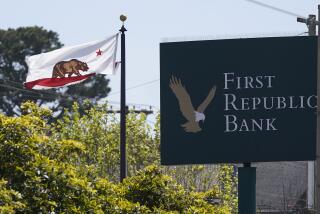Banking Industry Wants to Develop Self-Rescue Plan
- Share via
WASHINGTON — U.S. banking industry officials are huddling with federal regulators in a hasty but determined effort to develop a system of early financial aid for troubled banks to avoid costly collapses and government takeovers, sources said Friday.
The bankers have a dual goal: to ease public anxiety about the safety of America’s financial system and to persuade Congress that it is safe to give banks expanded powers to enter new lines of business.
The money for the plan would come from the banking industry itself. “The industry desperately wants to avoid all the implications of a taxpayer bailout,” said one banker, requesting anonymity.
“We’re talking about an early intervention scheme infusing bankers’ money into troubled institutions so that they would not go the route of the Bank of New England,” said another participant in the talks. The recent takeover of the Bank of New England will cost taxpayers an estimated $2 billion or more.
The government fund that insures bank deposits has lost money for three years in a row, and the latest projection by the Office of Management and Budget indicates the fund could run up a deficit of as much as $4 billion by the end of next year, regulatory officials said.
But Bush Administration officials are confident that the industry aid plan under consideration would be sufficient to offset the projected shortfall. L. William Seidman, chairman of the Federal Deposit Insurance Corp., has estimated that the industry, if pressed, could kick in as much as $25 billion over several years to shore up problem institutions.
Industry groups hope they can agree on a plan and then get the approval of federal regulators in time to “get a sentence or two” in the President’s State of the Union message on Tuesday, a source noted.
“We’ve invited banking groups to meet and see if they can come to agreement on a plan to minimize costs by stepping in and dealing with problems at an early stage,” a Bush Administration official said.
Next week, the Administration will unveil an ambitious financial reform plan aimed at tearing down many of the barriers built around banks after the failures of the Great Depression. The Administration wants to permit banks to enter fully into the fields of securities and insurance and to permit unfettered movement across state lines.
“Real reform for the financial system is for banks to return to profitability,” said Alfred Pollard, senior vice president in Washington for Security Pacific National Bank.
Banks suffered major losses on loans to Third World nations and have seen much of their corporate business defect to Wall Street, where investment bankers sell commercial paper (essentially corporate IOUs) to help companies raise funds. Real estate lending has become the biggest single activity of U.S. commercial banks, and the current weak market threatens the livelihood of many banks.
Expanded powers would give banks new opportunities to make money, “making taxpayer intervention unnecessary,” Pollard said.
Bush Administration officials offer the same argument. But their viewpoint may be met with considerable skepticism in Congress, which was just asked by the Treasury to vote for open-ended spending authority to finance the savings and loan cleanup.
Many thrifts, particularly those chartered by California and Texas, made dangerously speculative investments during the 1980s after being allowed to go beyond traditional home-mortgage lending.
Unlike the thrifts, the banking industry has a sound financial base, with more than $200 billion in capital. But that capital is being eroded as many banks set aside large sums to cover losses from real estate loans gone bad.
The debate over giving banks expanded powers is expected to be intense because of fears that the banks could stumble in their new businesses just as S&Ls; did, forcing taxpayers to foot the bill.
In an effort to assuage these fears in advance, the bankers are eager to demonstrate they can care for their own weak brethren.
The proposals under consideration in this week’s discussions include a new fund that would be run by the industry to provide capital for weak banks and to serve as a “warehouse” for bad real estate loans.
The participants also are considering a special one-time assessment on banks to bolster the federal deposit insurance fund, which would need at least $8 billion over two years, according to regulatory officials.
It is unclear whether all major segments of the banking industry can agree on a plan that would enable some of the weak competitors to remain in business using money from an early intervention fund.
“We already have too many banks,” said one participant in the closed-door talks. “We should provide aid only on the condition that the bank getting help agrees to a merger or a buyout in a reasonable period of time.”
The Treasury Department has not given its blessing to any of the proposals under consideration. “We have been in consultation with the industry and the Federal Deposit Insurance Corp. on a variety of proposals,” a spokeswoman said Friday. “Until we see a final plan, we will not know if we can accept it.”
More to Read
Inside the business of entertainment
The Wide Shot brings you news, analysis and insights on everything from streaming wars to production — and what it all means for the future.
You may occasionally receive promotional content from the Los Angeles Times.









